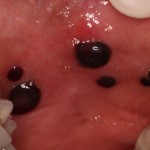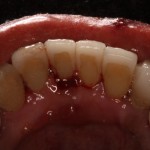Bleeding Gums & Bleeding Lesions
Case Presentation
A 60 year old african american patient was referred to me for a emergency evaluation of spontaneous bleeding gums and bleeding lesions. The patient’s medical history was non-contributory for significant diseases and the patient reports occasionally having a annual exam from a general physician. Also, the patient reports recently taking Mega Man dietary supplement prior to oral lesions appearing. Hard tissue charting was not completed due to the severity of the bleeding and placed the patient on a medrol dose pack to rule out allergic reaction. The patient was informed that a examination with CBC test by his physician was imperative.
Differential Diagnosis
Hemophilia, Thrombocytopenia, Periodontitis, Pernicious Anemia, Lymphoma, Leukemia
CBC Results
The patient was referred to his physician a complete examination and CBC analysis. A complete blood count was completed two days after initial examination at my office. Results included elevated white blood cell production and decrease in platelet count (~8000 ppm). The patient was admitted to the hospital for platelet injections and bone marrow biopsy. The tentative diagnosis of leukemia was identified with the oral hemorrhagic lesions being caused secondarily due to thrombocytopenia.
Leukemia
The clinical features may be acute or chronic, and cells of either the lymphocytic or myeloid series are most commonly involved. Acute lymphocytic leukemia is one of the more common childhood malignancies; chronic lymphocytic leukemia, the most common form of leukemia, primarily affects older adults. Acute myeloid leukemia affects a broad age range that includes children and adults. Chronic myeloid leukemia show a peak incidence in the third and fourth decades of life.
Clinical manifestations of leukemia include fatigability, anemia lymphadenopathy, hepatosplenomegaly, bone and abdominal pain, secondary infection, and hemorrhagic lesions secondary to thrombocytopenia. Oral lesions are more common in myelocytic/monocytic leukemias and may include gingival leukemic infiltrates, severe periodontal bone loss, oral ulcerations, and hemorrhagic lesion. Treatment and prognosis depends on the specific type of leukemia. Therapy primarily centers around chemotherapy and, in some cases, bone marrow transplantation.
- Hemorrhagic Lesions
- Bleeding Gums





 by
by 


